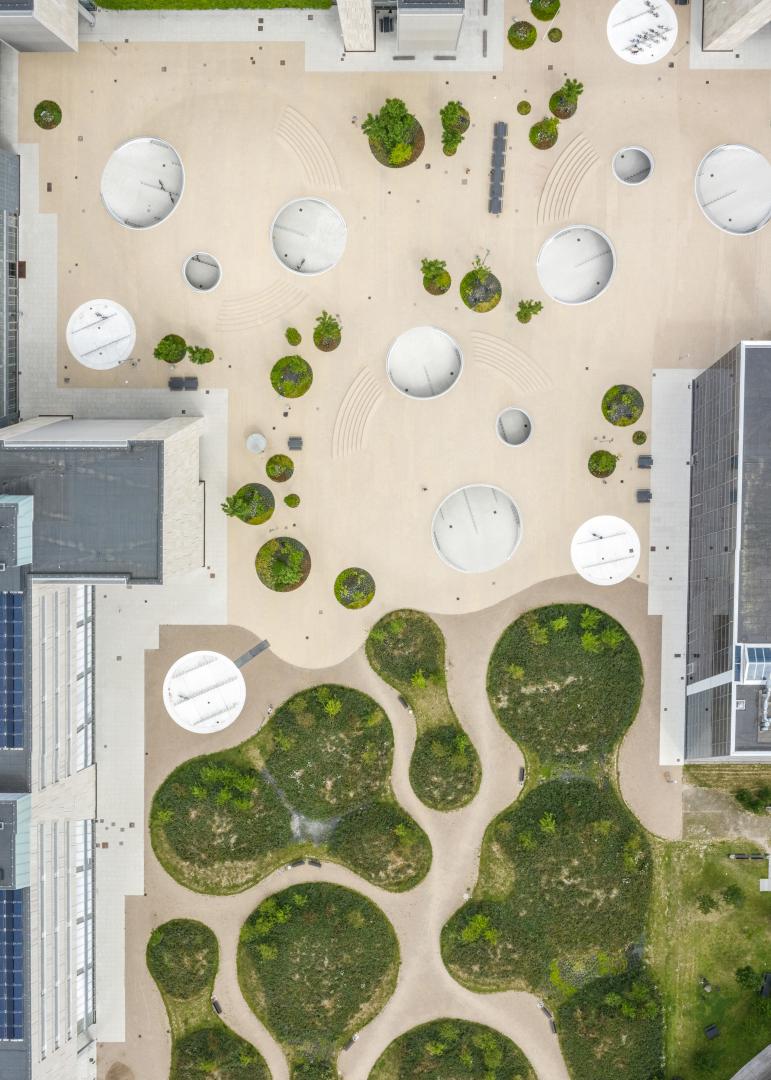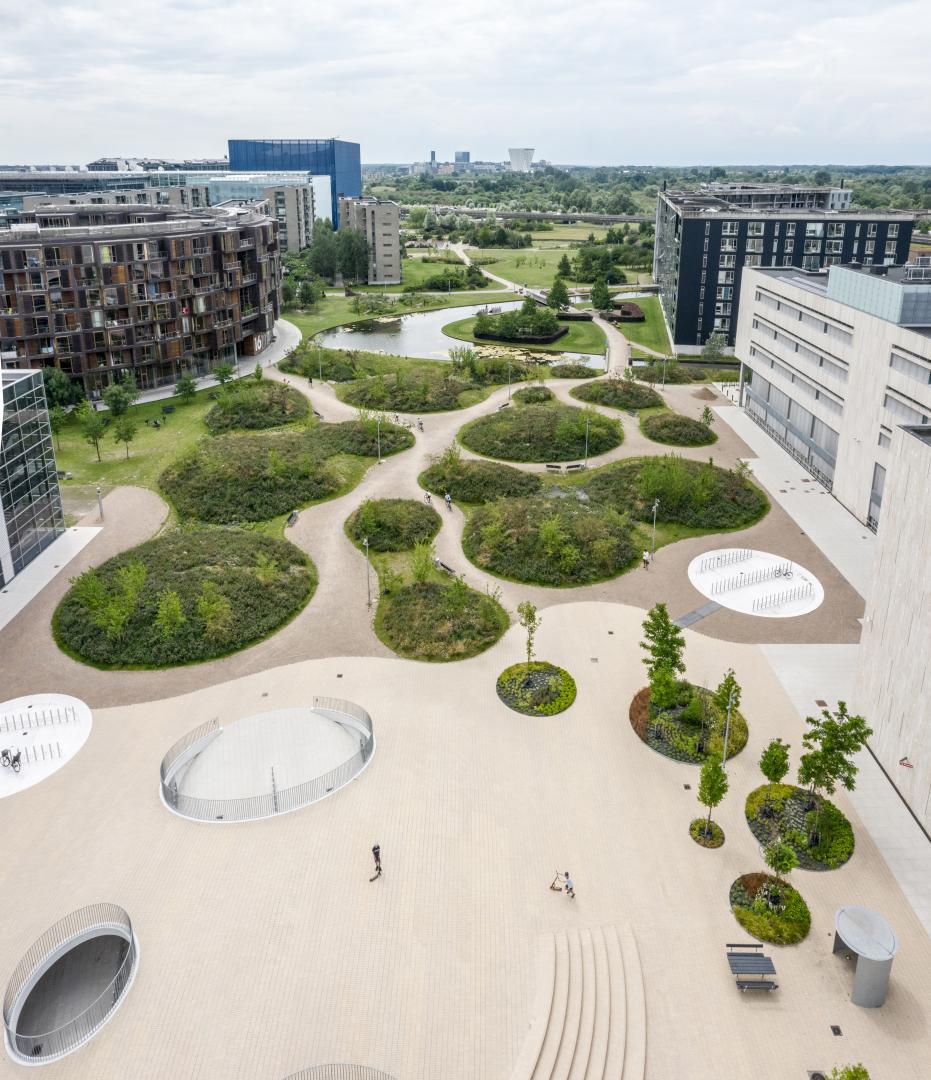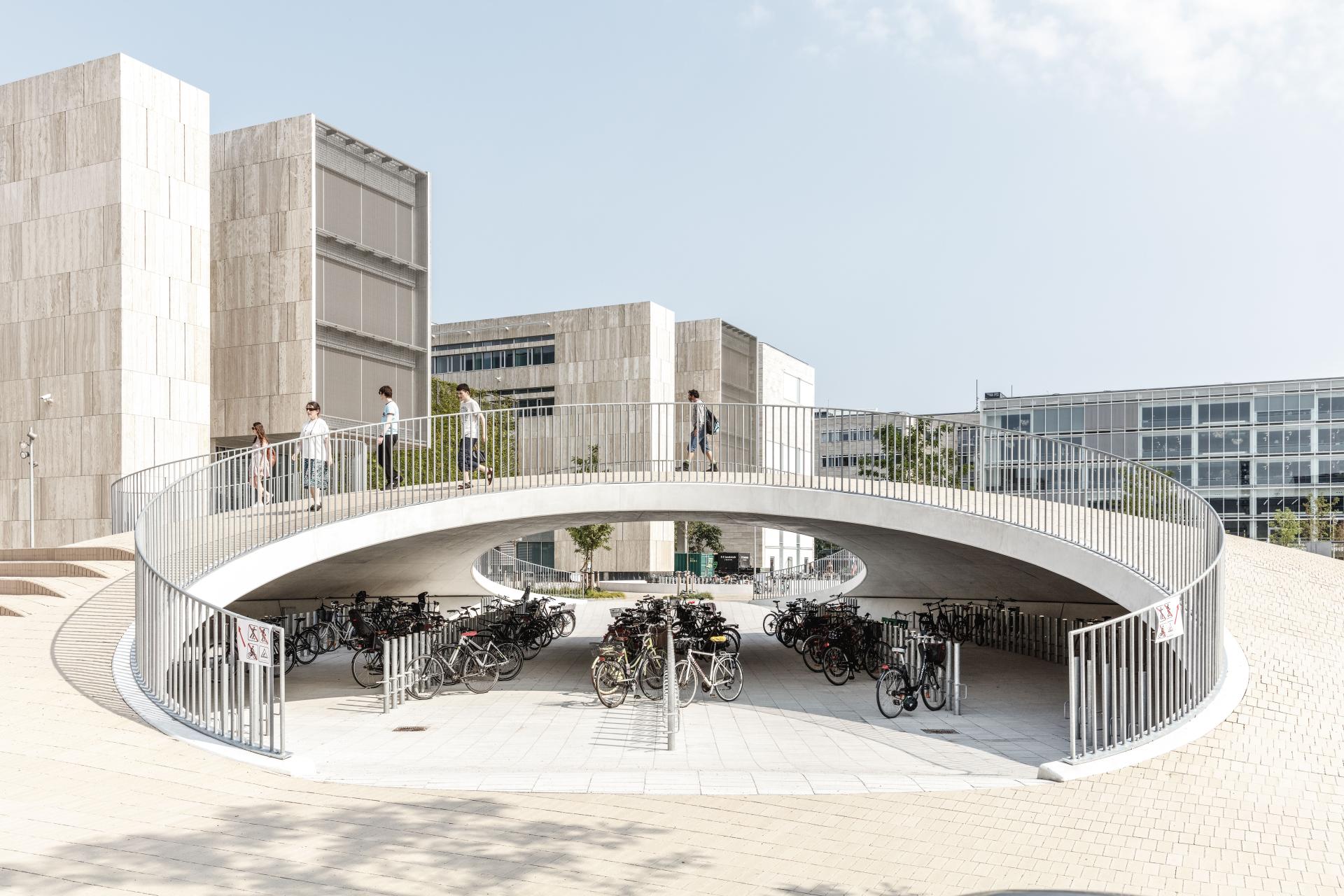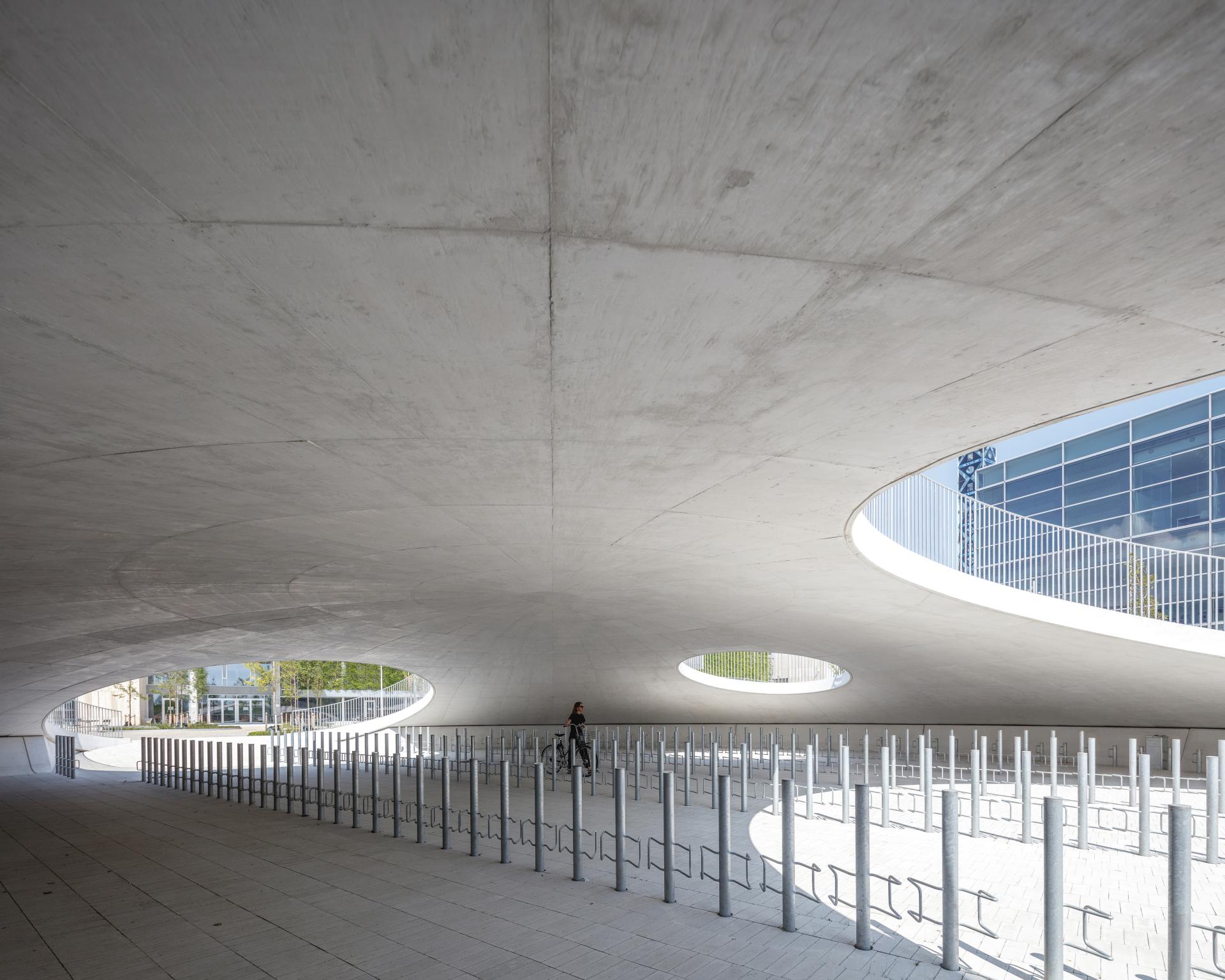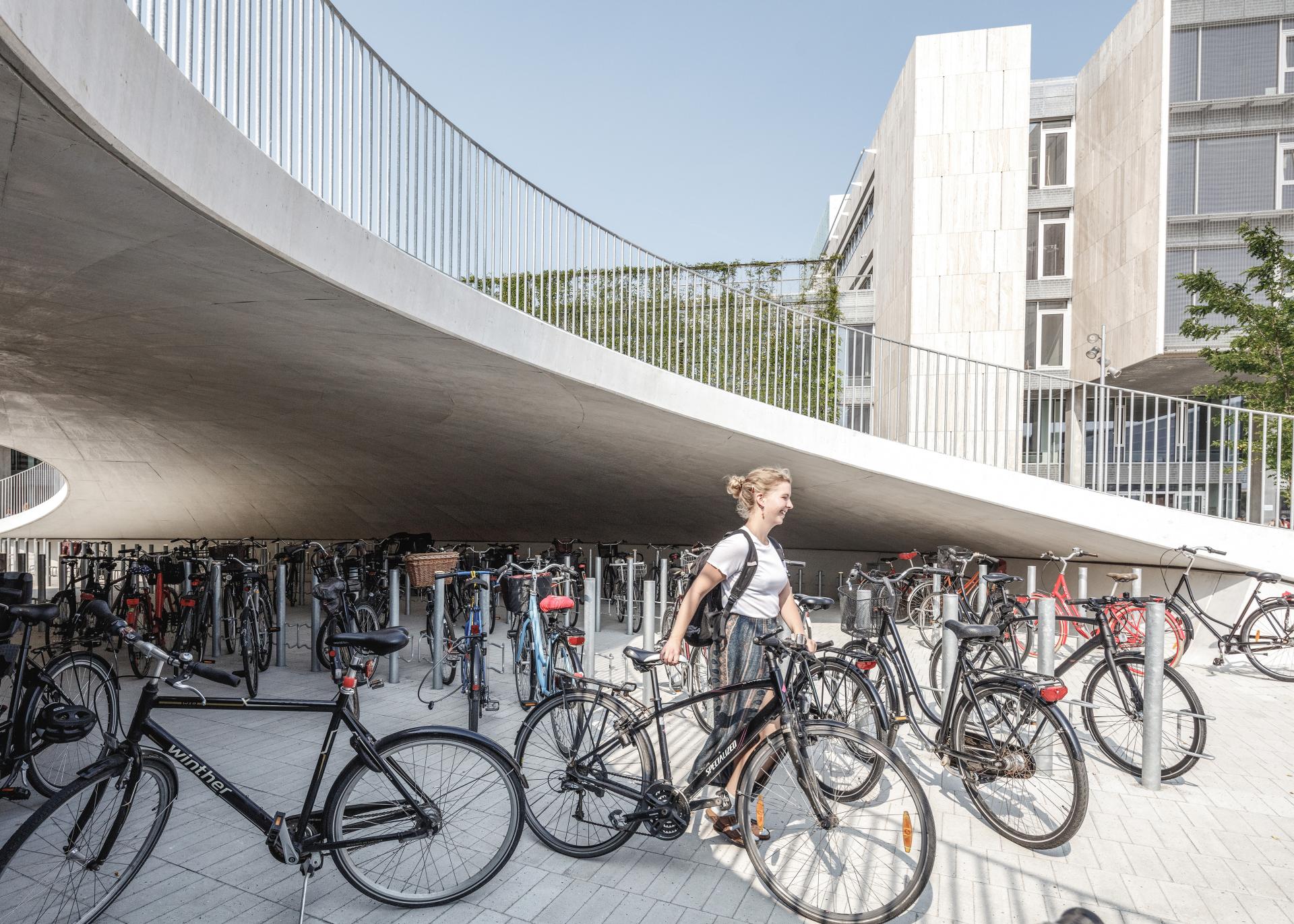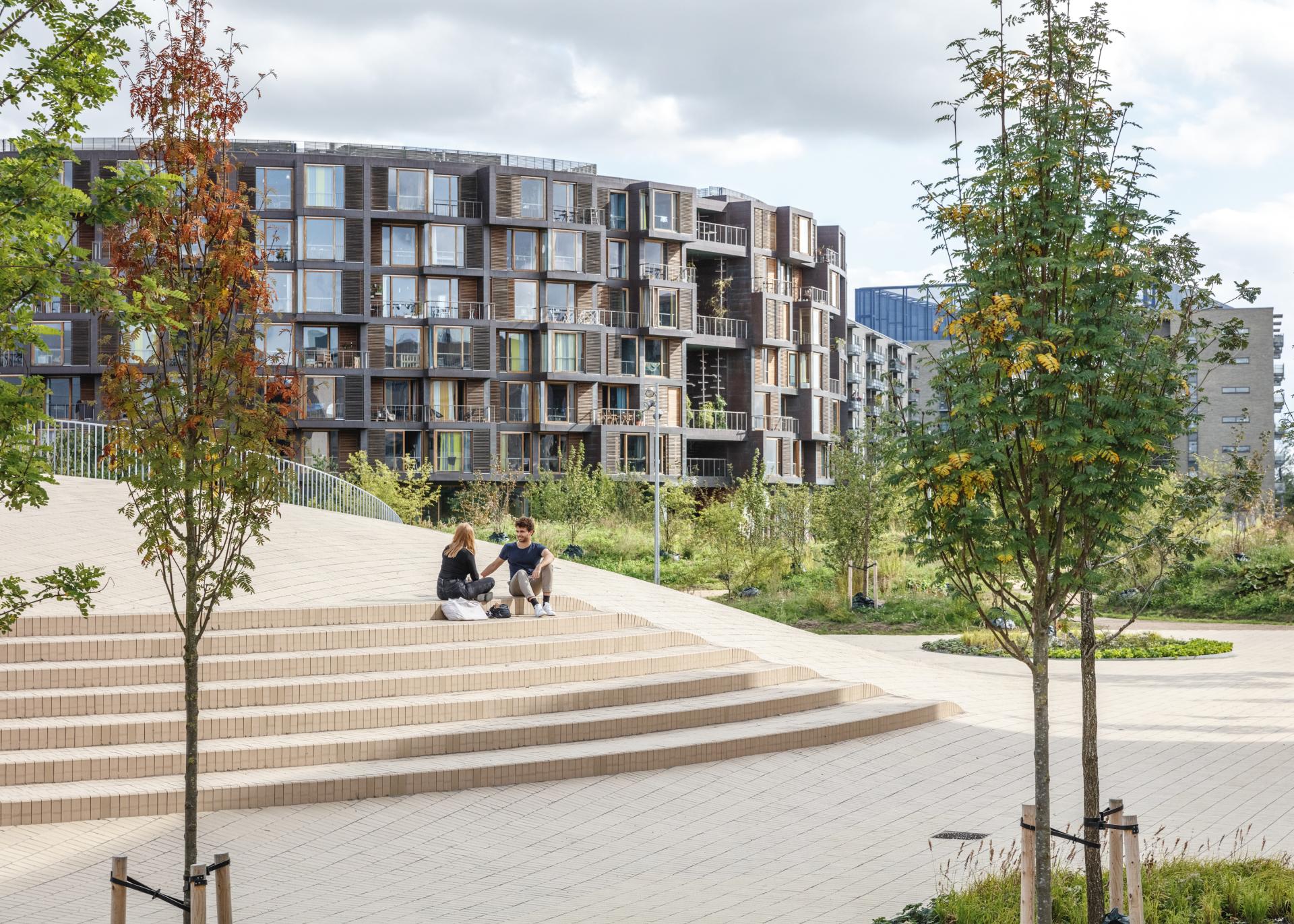Karen Blixens Plads
Basic information
Project Title
Full project title
Category
Project Description
Occupying approx. 20,000 m², Karen Blixens Plads is one of the biggest urban spaces in Copenhagen. It is connected to Amager Commons through a gradual transition, which makes it a hybrid of park and public square, organized as a superimposed surface of human-made hills and valleys with room for 2,000 parked bicycles inside the hills. The square has an important functional role as well as a recreational resource. The necessary infrastructure is turned into a three-dimensional community hang-out.
Project Region
EU Programme or fund
Description of the project
Summary
Karen Blixens Plads is an urban space at the University of Copenhagen South Campus in Copenhagen, Denmark. Occupying approximately 20,000 m², Karen Blixens Plads is one of the biggest public squares in the city. The plaza is located between the recently built university buildings of the South Campus and the nature reserve Amager Commons. The urban space is connected to Amager Commons through a gradual transition, which makes Karen Blixens Plads a hybrid of park and public square, organized as a superimposed surface of human-made hills and valleys with room for 2,000 parked bicycles inside the hills. Three types of bicycle parking are created - bicycle hills and two types of bicycle beds. Both uncovered and covered and slightly lowered in the ground.
The plaza is organized with a 50/50 hardscape and soft surface split, with room for both high capacity bicycle traffic and parking, rainwater collection, stormwater management, and large social events for more than 1,000 people. The 10,000 m² green park supports the natural biodiversity of the neighboring commons, reducing heat island effects, cleaning the air, and creating stress relief for people. The informal and playful design inspires people of all ages to socialize, move and play while encouraging green mobility.
Overall, the square works as a public landscape with an important functional role as well as a recreational resource. The necessary infrastructure is turned into a three-dimensional community hang-out.
Client: Danish Building and Property Agency and A.P. Møller og Hustru Chastine Mc-Kinney Møllers Fond til Almene Formål
Architect and Landscape architect: Cobe
Engineers: EKJ, CN3, Vind-Vind
Contractors: M.J. Eriksson, NCC
Key objectives for sustainability
Open spaces in Copenhagen are under increasing pressure to perform infrastructural, technical tasks, handle stormwater, reduce heat island effects, offer places for people to socialize while leaving room for natural habitats. Karen Blixens Plads is attempting to tackle multiple of these environmental challenges - including climate change adaption, rainwater management, increasing biodiversity, and encouraging green mobility while enriching the local community with a new unique space for social interaction.
The Danish Meteorological Institute predicts a 50% rise in rain intensity in the near future, calling for new ways to delay, store and manage rainwater. Karen Blixens Plads is showcasing multiple strategies to handle various stormwater events. Delaying the draining of rainwater in depressions, the design utilizes the recreational values of the water, while creating small wet biotopes supporting biodiversity, enabling rainwater evaporation, and supplementing the canal in case of extreme precipitation.
The increasingly extreme weather events have created an awareness of the implications of a heating environment. Storage, delaying, and slow seepage of water on-site and the natural containment of water in plants have a documented effect on local cooling. At Karen Blixens Plads the extensive vegetation helps local cooling of an area characterized by hardscape surfaces.
With 50% of the plaza being dedicated to green biotopes for the neighboring commons to expand into the context of the city, the design supports and respects the local biodiverse habitats for flora and fauna. Species of plants are carefully selected to complement the durable, wind-resistant, drought and flood resilient species from the neighboring commons.
Located at a central metro stop, the square effectively works as a large-scale soft mobility hub for daily commuters promoting green mobility and providing effective and attractive bicycle parking for the 49% of daily bike commuters in Copenhagen
Key objectives for aesthetics and quality
The bicycle hills are created as concrete domes with a shell construction as the load-bearing structure. The materiality of the surrounding buildings is predominantly defined by travertine façade claddings and green elements such as hanging gardens. Inspired by its surroundings, the design of Karen Blixens Plads puts emphasis on choosing mainly simple and durable materials. Tiles are used as the main surface material, echoing the colors of the surrounding buildings and creating a coherent identity for the campus area. The materials are all long-lasting with a low maintenance cycle, and easily recyclable. The cathedral-like bicycle hills are an aesthetic experience in itself – both when parking your bike and gathering on the hills for lectures, group work, or other social events.
Key objectives for inclusion
Karen Blixens Plads is designed with the ambition to create the best possible outdoor conditions for the users of the university and the surrounding community. One of the core strategies in the development was to create high-quality conditions for pedestrians and bicyclists, promote physical activity and green mobility, and create an attractive urban space for both campus and community interaction. The square offers a wide variety of spaces for formal and informal activities, for activity and recreation, for private encounters, and for social interaction, and is closely connected with the surrounding city fabric and accessible for all users. The informal and playful design inspires people of all ages and cultural backgrounds to socialize, move and play. The layout of the square is open and transparent, with no dark corners, contributing to a feeling of safety.
Results in relation to category
For a long time, the university square was a dull grey parking area for bikes, in an unfriendly scale and with no spatial hierarchy. Although it was one of the biggest public spaces in the city, it was also one that few people used.
With the transformation, the project has created a huge impact on the social cohesion of the local community and the various users by providing a new unique and multifunctional meeting place instead of the former worn-out and messy parking area.
The square has become a popular destination in the neighborhood, inviting the local community and users at the university to interact by offering a wide variety of spaces for both formal and informal activities, for physical activity and quiet recreation, for private encounters, and for social events. It encourages people of all ages to physical movement - to run, bike, skate, or scooter around the plaza, and to choose bicycling as a mode of transportation by serving as a soft mobility hub offering effective and attractive parking.
Karen Blixens Plads also has a large environmental impact and has recently won the Danish Building Award’s Climate Prize 2020. The design delivers multiple strategies for climate change adaption, handling stormwater events, enabling rainwater management, and creating small wet biotopes that support biodiversity.
Instead of just solving the existing parking problem for bicycles, the project has created an innovative, spectacular, and multifunctional meeting place in the city, where a double layer of programming turns dull bicycle infrastructure into an interesting and inviting public community space while accommodating and promoting green transportation, climate change adaptation, and biodiversity.
How Citizens benefit
Karen Blixens Plads has due to its size and central location in the middle of one of the capital’s busiest research and education environments had a very strong starting point to become one of Copenhagen’s new prominent seats and an active meeting place for students, staff, and visitors. It is this very fact, the being surrounded by researchers, institutes, and faculties of humanities that has lifted the ongoing debate on user participation and quality to the next level.
Both the staff and student body on campus have been engaging in an open dialogue, trying to help find answers on how to develop a common identity of their specialized centers, institutes, and faculties, and at the same time forging strong bonds with the surrounding society.
Due to the high construction activity in the area for more than two decades prior to the Karen Blixens Plads project, the society’s interest has been high, which has started off a strong framework of conditions. The involvement has led to the university square having been subject of design twice prior to Cobe’s Karen Blixens Plads proposal.
In addition, the closeness to Copenhagen’s biggest nature reserve, the neighboring commons, and the strength of its advocates has made sure to provide a common green open space on more than 50% of the site. It led to the motion of drawing in the natural reserve into the university square, while at the same time mediating a balanced transition between the urbanity of a university square and the biodiverse nature of the green area.
Innovative character
Copenhagen is one of the world’s leading bicycle cities, with nearly half of the city’s inhabitants riding their bikes for their daily commute. This challenges the city to find innovative solutions to both the city’s infrastructure and its increasing bicycle-parking demands. Karen Blixens Plads is located near the metro station and effectively works as a large-scale soft mobility hub providing parking for more than 2,000 bicycles – two-thirds of them in covered spaces inside the bicycle hills. The public space is designed to create intuitive, high-volume parking without seeming spatially dominating or visually cluttering. Bikes can be parked under the domes or in sunken bicycle-parking beds. In addition, the hills and beds provide edges for seating and socializing while keeping the parking tidy and supporting the clean and free horizontal sightlines across the plaza. The almost cathedral-like form of the bicycle hills further offers an aesthetic experience in its own right, turning necessary bicycle infrastructure into a public community space and social destination.
The result is a campus square that offers a variety of spaces, which are well connected to the city fabric and easily accessible for all users, promoting green transportation and climate change adaptation. The plaza offers three types of bicycle parking – uncovered, covered, and slightly sunken into the terrain – and creates a landscape of hills that people can walk on top of or sit among in addition to using the bicycle parking. The double layer of programming turns bicycle infrastructure into an inviting urban living room and community hang-out.

